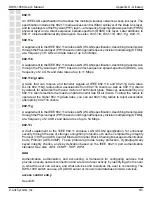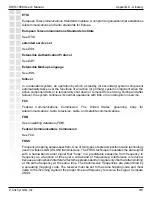
423
DWS-1008 User’s Manual
D-Link Systems, Inc.
Appendix D - Glossary
infrastructure network
One of two IEEE 802.11 network frameworks. In an infrastructure network, all communications
are relayed through an access point (AP). Wireless devices can communicate with each
other or with a wired network. The network is defined by the distance of mobile stations from
the access point, but no restriction is placed on the distance between stations. Stations must
request association with the access point to obtain network services, which the access point
can grant or deny based on the contents of the association request. Like most corporate
wireless LANs (WLANs), which must access a wired LAN for file servers and printers, a
D-Link Mobility System is an infrastructure network. Compare
ad hoc network
.
initialization vector (IV)
In encryption, random data used to make a message unique.
Institute of Electrical and Electronic Engineers
See
IEEE
.
integrity check value
See
ICV
.
interface
A place at which independent systems meet and act on or communicate with each other, or
the means by which the interaction or communication is accomplished.
International Organization for Standardization
See
ISO
.
Internet Authentication Service
See
IAS
.
Internet Group Management Protocol
See
IGMP
.
Interswitch Link
See
ISL
.
ISL
Interswitch Link. A proprietary Cisco protocol for interconnecting multiple switches and
maintaining virtual LAN (VLAN) information as traffic travels between switches. Working in
a way similar to VLAN trunking, described in the IEEE 802.1Q standard, ISL provides VLAN
capabilities while maintaining full wirespeed performance on Ethernet links in fullduplex
or halfduplex mode. ISL operates in a point-to-point environment and supports up to
1000 VLANs.
















































